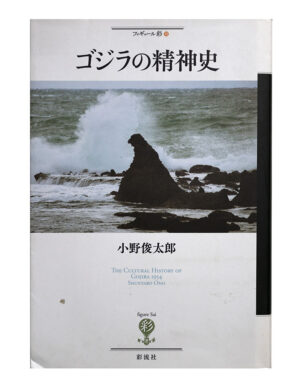10.17.2022
The Cultural History of Godzilla – Pt 17


P 40
第二章
Chapter II
ゴジラの精神史
Godzilla’s spiritual history
海に潜むものの影
Shadow of what lurks in the sea
ヘルメット式潜水術
Helmet diving
「ゴジラ」は、栄光丸が航跡を描く海のショットで始まり、オキシジェン・デストロイヤーの威力で骨まで溶けたゴジラを飲みこんだ海のショットで終わる。まるで海から生まれたゴジラが海へと還っていったような錯覚を与え、海の表面が平穏となることで収束する。山根博士の最後の有名なセリフは「あのゴジラが最後の一匹だとは思えない」だったが、それは平和に見える海に潜む恐怖について語っているのだ。
“Godzilla” begins with a shot of the ocean where Eikomaru traces its wake, and ends with a shot of the ocean swallowing Godzilla, which has been melted to the bones by the power of the Oxygen Destroyer. It gives the illusion that Godzilla was born from the sea and returned to the sea, and the surface of the sea becomes calm and converges. Dr. Yamane’s last famous line, “I can’t believe that Godzilla is the last one,” speaks of the horrors that lurk in the seemingly peaceful sea.
この映画で海は大きな役割をはたしている。もちろん島国である日本に他所から近づくには、海路空路の選択しかない以上、空を飛べないゴジラが大戸島から北上し、東京湾へと海の中を進んでい水路をとるのは当然だろう。この映画に戦争の記憶が色濃く残っていることは、多くの人が指摘している(川本三郎『今ひとたびの戦後日本映画』など)。そのときに、銀座をはじめ燃え上がる夜の街の光景は、一九四五年三月十日の東京大空襲に代表される空襲の記憶と結びつくという指摘もよくわかる。
The sea plays a big role in this movie. Of course, the only way to approach Japan, an island country, is by sea or by air, so it’s only natural that Godzilla, who can’t fly, would head north from Odo Island and head for Tokyo Bay through the water. Many people have pointed out that this movie has a strong memory of the war (e.g., Saburo Kawamoto’s “Postwar Japanese Films Now”). I can also understand the point that it is connected to the memory of the air raids represented by the Tokyo air raid on March 10, 1945.

P 41 (42)
けれども、ゴジラがもたらす被害そのものは空からやってきたわけではない。それに空襲のなかには、四五年の五月二十九日の横浜大空襲のように白昼行われて、昭和天皇が皇居から見える煙を心配したものもある。ゴジラの最初の出現場所が硫黄島の近くであったように、『ゴジラ』における戦争の記憶はまず何よりも海と結びついている。この章では海のイメージを原作者の香山滋と監督の本多猪四郎がどのように共有していて、映画の中に投影したのかを考えてみたい。
However, the damage that Godzilla does does not come from the sky. Moreover, some air raids, such as the Great Yokohama Air Raid on May 29, 1945, were carried out in broad daylight, and Emperor Showa worried about the smoke that could be seen from the Imperial Palace. Just as Godzilla’s first appearance was near Iwo Jima, the memories of war in Godzilla are first and foremost tied to the sea. In this chapter, I would like to consider how the original author Shigeru Kayama and director Ishiro Honda shared the image of the sea and projected it into the film.
*
ゴジラが大戸島に上陸するまでに起きた海難事故を伝える新聞に「浮流機雷か」という見出しが見 える。映画では一瞬のうちに通り過ぎてしまう文字だが、これは物語のロマンス上の主人公である尾形秀人が「南海サルベージ」で働く潜水夫だったり、海上保安庁の巡視船しきねに乗って活躍することと結びつくので見過ごせない。
In the newspaper reporting on the marine accidents that occurred before Godzilla landed on Odo Island, you can see the headline “floating mines?” In the movie, the characters pass by in an instant, but this is because Hideto Ogata, the main character in the romance of the story, is a diver working at the “Nankai Salvage” and is active on the Japan Coast Guard patrol ship Shikine. You can’t miss it because it’s tied to things.
映画を観ていると、南海汽船の子会社に所属する民間人の尾形が、日本の沿岸警備を担当する公の船上で働いているのに違和感をもつ。ところが、これは主人公をどこまでも活躍させたいという物語上の要請ではなくて、民間に業務を委託していたという時代的な背景をきちんともっていた。尾形がしゅんせつ おこなっているサルベージ業は、沈没船の撤去や港湾の浚渫にかかわり、戦後の復興にとって欠かせない仕事だった。会社の黒板にも「船体引揚作業」の日程などが書きこまれている。
When watching the movie, it feels strange to see Ogata, a civilian belonging to a subsidiary of Nankai Kisen, working on a public ship in charge of Japan’s coast guard. However, this was not a narrative request to let the main character play an active role, but it had the historical background of outsourcing the work to the private sector. The salvage business that Ogata has been working on for a long time involved the removal of sunken ships and the dredging of harbors, which was essential for post-war reconstruction. The schedule for the hull salvage work is also written on the company’s blackboard.
現在でも津波や土石流のあとで大量の土砂や堆積物に埋まった漁場や港湾を整備するには、最終的には潜水作業で人の手によって障害物を除去するしかない。『ゴジラ』では、地上や船上からポンプで空気を送るヘルメット式潜水がとられている。二〇一三年のテレビドラマ『あまちゃん』でも、羽田空港の拡張工事や東日本大震災の後の港湾整備に活躍する「南部もぐり」が紹介されたように、ヘルメット式潜水は現役の技術である。寒冷地でも活躍できるので、一八五七年(安政四年)に日本に入ってきて以来現在も使われている(社団法人日本潜水協会のサイトの説明)。「ゴジラ」の当時は難破 船の引き上げにはじまって、さまざまな場面で活躍していた。
Even today, the only way to maintain fishing grounds and harbors buried in large amounts of earth, sand, and sediments after tsunamis and debris flows is to remove obstacles by hand using diving. In “Godzilla,” helmet-type diving is adopted, in which air is pumped from the ground or on board. The 2013 TV drama “Ama Chan” introduced the “Nanbu Moguri,” which plays an active role in the expansion of Haneda Airport and port maintenance after the Great East Japan Earthquake. Helmet-type diving is an active technology. Since it can be used in cold climates, it has been used since it came to Japan in 1857 (ansei 4) (explanation on the website of the Japan Diving Association). At the time of “Godzilla,” he was active in various scenes, including salvaging shipwrecks.